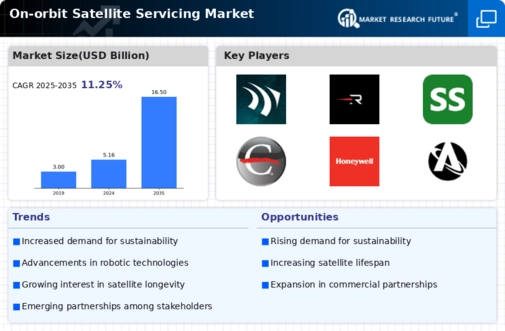Emerging Commercial Space Sector
The On-orbit Satellite Servicing Market is witnessing a transformation driven by the emergence of a robust commercial space sector. Private companies are increasingly entering the satellite servicing arena, offering innovative solutions that challenge traditional models. This influx of competition is likely to drive down costs and enhance service offerings, making satellite servicing more attractive to operators. The commercial sector's agility and willingness to invest in new technologies could lead to rapid advancements in servicing capabilities. Analysts suggest that the commercial space market could contribute significantly to the overall growth of the servicing industry, with projections indicating a multi-billion dollar market by the end of the decade.
Government Initiatives and Funding
The On-orbit Satellite Servicing Market is being bolstered by various government initiatives and funding programs aimed at enhancing space capabilities. Governments are increasingly recognizing the strategic importance of satellite servicing for national security and economic competitiveness. Funding for research and development in this area is on the rise, with several countries establishing partnerships with private companies to advance servicing technologies. This collaborative approach is likely to accelerate innovation and reduce the time to market for new servicing solutions. As government investments continue to flow into the sector, the market is expected to expand significantly, with estimates suggesting a potential increase in funding by billions of dollars over the next few years.
Advancements in Robotics and Automation
The On-orbit Satellite Servicing Market is benefiting from significant advancements in robotics and automation technologies. These innovations enable more complex servicing operations to be conducted in space, such as autonomous repairs and upgrades. The integration of sophisticated robotic systems allows for increased precision and efficiency, reducing the need for human intervention. As a result, the cost of servicing missions is likely to decrease, making them more accessible to a broader range of satellite operators. The market for robotic servicing solutions is projected to grow substantially, with estimates indicating a potential increase in investment in this sector by several billion dollars over the next decade.
Increasing Demand for Satellite Longevity
The On-orbit Satellite Servicing Market is experiencing a surge in demand for extending the operational life of satellites. As satellite operators face the high costs associated with launching new satellites, servicing existing ones appears to be a more economically viable option. This trend is underscored by the fact that the average lifespan of satellites has been increasing, with many now expected to operate for over 15 years. Servicing missions can include refueling, repairs, and upgrades, which can significantly enhance the longevity of these assets. According to recent estimates, the market for satellite servicing could reach several billion dollars by the end of the decade, driven by the need for cost-effective solutions in satellite management.
Growing Interest in Space Debris Mitigation
The On-orbit Satellite Servicing Market is increasingly focused on addressing the pressing issue of space debris. As the number of operational satellites continues to rise, so does the risk of collisions and the creation of additional debris. Servicing missions that include debris removal or the repositioning of satellites to safer orbits are gaining traction. This is particularly relevant as regulatory bodies and space agencies emphasize the importance of sustainable practices in space operations. The potential for debris mitigation services could represent a substantial segment of the market, with estimates suggesting that investments in this area may exceed hundreds of millions of dollars in the coming years.

















Leave a Comment